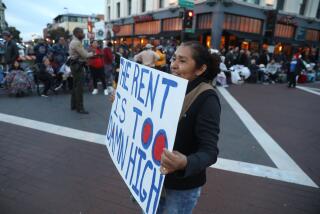The debt, the future and other parting thoughts
After 35 years in daily journalism, this is a farewell: I’m leaving The Times on Dec. 2 to see what else I might do with the rest of my working life.
I’ve had a dream of a career, which began in the newsroom of the student paper at the Ohio State University. The best of it has been working among the incredibly talented staffers of The Times since arriving here in 1990.
I’m stepping away at a time that is strikingly reminiscent of my first few years in the business of covering financial markets and the economy. That was 1979-82, in what was then considered the worst U.S. economy since the Great Depression.
Sound familiar?
Like today, short-term interest rates were at extremes in 1979, but at the opposite end of the spectrum: Today short rates are near zero; in ’79 they were in double digits because people feared that the nation was about to enter hyperinflation.
Many Americans’ attitude toward the stock market was exactly the same then as now. In 1979 the market was mistrusted or outright despised. What was the point of owning stocks? The Dow Jones industrial average was no higher in 1979 than it had been in 1964.
The economy got worse until 1982, when unemployment finally peaked just under 11% — above the current rate of 9%. I remember economists that summer warning about the potential for another depression.
Instead, an economic expansion began in late 1982 that lasted until 2007, with only minor interruptions along the way. The Standard & Poor’s 500 stock index produced returns averaging 12.7% a year from the end of 1982 through 2007.
If we escaped that terrible economy of the early 1980s, why can’t we get out of this one?
It’s quite possible that America will surprise itself, and the world, with its economic resiliency.
But it will be far more difficult climbing back for the reason that is well-known to all: the debt.
The federal government began a borrowing binge in 1982 that helped pull the economy out of its funk but also set a dangerous precedent. Annual budget deficits of more than $200 billion became routine by the early 1990s, which gave way to red ink of more than $300 billion by the early 2000s. Now we’re in the trillions.
Consumers also began to pile on debt in the 1980s at a rapid pace, which continued into the 2000s as incomes stagnated.
To varying degrees, European countries followed down the same path. So did Japan.
So the debt crisis that began with the U.S. housing bust in 2007 has become the defining issue of our era. Too many people, and governments, simply owe too much.
Think of it this way: The prosperity of the 1990s and 2000s was in part stolen from the future. Borrowing allowed for immediate gratification. Now the bills are coming due.
The situation has become critical in Europe, as investors keep demanding ever-higher yields on government bonds, reflecting growing doubts about countries’ abilities to repay their debts.
On Friday, the market yield on 10-year Italian bonds was 7.26%, a new euro-era high and up from 5.95% a month ago and 4.39% a year ago.
Every jump in borrowing costs makes it that much harder for Europe to dig out of its hole. Yet why should investors be willing to accept lower interest rates given that the continent seems at serious risk of a financial meltdown? Catch-22, anyone?
How do we get out of this? The answer is the one nobody wants to hear: We need time to work through the debt. A long time.
The doomsday scenario is that it’s already too late, and that Western capitalism will be a victim of its own wretched excesses.
I’ve heard that plenty of times in the last 35 years. If it’s finally coming true, the only advice worth offering is to stock up on canned food, water and ammunition.
Assuming you want to believe that life somehow goes on, here are some parting thoughts about the future of the economy and markets:
• As someone once said, “hope” is not an investment strategy. But it’s what keeps civilization advancing. The debt weight notwithstanding, the world — and particularly the developing world — isn’t going to stop wanting to live better, to succeed, to move up.
• Apropos of the above, consider the social revolutions in the Middle East and North Africa this year. If not for Europe’s crisis dominating the headlines, financial markets might well be celebrating the long-term implications of the demise of authoritarian regimes.
• Afraid to invest, individuals and businesses have built up enormous cash hoards since 2007. There is $8.6 trillion sitting in U.S. bank savings accounts and money market mutual funds, earning virtually nothing. Cash feels good to have right now, but that is a massive amount of capital that one day could look for more productive uses, like financing new businesses.
• Financial markets are always about psychology. Right now, the psychology is grim. Investors certainly have to ask whether they’re prepared for things to get worse. But it’s also a good idea to wonder how markets (and your portfolio) might fare if things actually get better.
• The worst thing about the 1980s and ‘90s was that people came to believe that investing was easy. It isn’t. It requires thinking. It’s work. Yet people will spend far more time researching restaurant menus than their 401(k) savings options.
• The best advice if you’re young: Save as much as you can. In the long run, where you save it isn’t as important as how much you save at an early age. My first investment was $1,000 in a stock mutual fund in 1982. I only wish it had been $2,000.
• It’s OK to hate Wall Street. But hating the stock market by extension? That’s dumb. Short of Armageddon, plenty of companies are going to do very well over the next two decades selling the world what it wants and needs. The stock market is a way to get a piece of that.
• “The game is rigged” seems like a good excuse for avoiding investment risk of any kind, particularly in stocks. But you still face the question: How to pay for retirement?
• One of my favorite magazine covers of all time led with the headline “What Went Wrong in the Wild Stock Market.” It was a Life magazine cover from June 1962. We curse our market’s ridiculous volatility, but it’s all relative.
• Ultimately, investment success or failure is very often about the price you pay for something. “Buy low, sell high” still is the basic idea. But human nature drives us to want to buy when prices are up and stay away when they’re down. Fight human nature.
• The continuing surge in long-term interest rates across Europe is a warning about what could happen one day with U.S. rates. If you own bonds and you don’t understand how rising rates devalue older bonds, it’s time to study up on that risk.
• Likewise, if the path out of the debt crisis is for central banks to print even more money and fuel rising inflation, that will be bad for bonds.
• It’s possible that the next 20 years will look like the 1950s and ‘60s in one sense: Investors may count more on earning rising dividend income from stocks than on capital gains. That’s one advantage blue-chip stocks have over bonds: Dividends can go up; bond interest is fixed.
• The Occupy Wall Street movement has one thing right: The problem of wealth disparity in America is a recipe for social unrest. Factor that into whatever else you imagine the future will look like.
• Gold is a silly investment ... except that it has been craved by humans for several thousand years. If it makes you feel better to have some gold as an insurance policy, it’s not silly.
• You can’t predict the future, and in this environment that means diversifying your assets as much as you possibly can. Here’s the good news: You have more investing possibilities available to you today than ever before.
Many small investors believe they’re at an inherent disadvantage to big-money players. I could argue just the opposite: You can be more nimble than the big players, you can be more patient, and you have only yourself to answer to.
Good luck.






